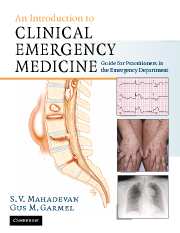Book contents
- Frontmatter
- Contents
- List of contributors
- Foreword
- Acknowledgments
- Dedication
- Section 1 Principles of Emergency Medicine
- Section 2 Primary Complaints
- 9 Abdominal pain
- 10 Abnormal behavior
- 11 Allergic reactions and anaphylactic syndromes
- 12 Altered mental status
- 13 Chest pain
- 14 Constipation
- 15 Crying and irritability
- 16 Diabetes-related emergencies
- 17 Diarrhea
- 18 Dizziness and vertigo
- 19 Ear pain, nosebleed and throat pain (ENT)
- 20 Extremity trauma
- 21 Eye pain, redness and visual loss
- 22 Fever in adults
- 23 Fever in children
- 24 Gastrointestinal bleeding
- 25 Headache
- 26 Hypertensive urgencies and emergencies
- 27 Joint pain
- 28 Low back pain
- 29 Pelvic pain
- 30 Rash
- 31 Scrotal pain
- 32 Seizures
- 33 Shortness of breath in adults
- 34 Shortness of breath in children
- 35 Syncope
- 36 Toxicologic emergencies
- 37 Urinary-related complaints
- 38 Vaginal bleeding
- 39 Vomiting
- 40 Weakness
- Section 3 Unique Issues in Emergency Medicine
- Section 4 Appendices
- Index
13 - Chest pain
Published online by Cambridge University Press: 27 October 2009
- Frontmatter
- Contents
- List of contributors
- Foreword
- Acknowledgments
- Dedication
- Section 1 Principles of Emergency Medicine
- Section 2 Primary Complaints
- 9 Abdominal pain
- 10 Abnormal behavior
- 11 Allergic reactions and anaphylactic syndromes
- 12 Altered mental status
- 13 Chest pain
- 14 Constipation
- 15 Crying and irritability
- 16 Diabetes-related emergencies
- 17 Diarrhea
- 18 Dizziness and vertigo
- 19 Ear pain, nosebleed and throat pain (ENT)
- 20 Extremity trauma
- 21 Eye pain, redness and visual loss
- 22 Fever in adults
- 23 Fever in children
- 24 Gastrointestinal bleeding
- 25 Headache
- 26 Hypertensive urgencies and emergencies
- 27 Joint pain
- 28 Low back pain
- 29 Pelvic pain
- 30 Rash
- 31 Scrotal pain
- 32 Seizures
- 33 Shortness of breath in adults
- 34 Shortness of breath in children
- 35 Syncope
- 36 Toxicologic emergencies
- 37 Urinary-related complaints
- 38 Vaginal bleeding
- 39 Vomiting
- 40 Weakness
- Section 3 Unique Issues in Emergency Medicine
- Section 4 Appendices
- Index
Summary
Scope of the problem
Acute chest pain is the presenting complaint in roughly 3% of emergency department (ED) patients. The diagnostic possibilities range from the immediately life-threatening (myocardial infarction (MI), unstable angina (USA), aortic dissection (AD), pulmonary embolism (PE), ruptured esophagus) to the self-limiting (chest wall strain), and the common (gastroesophageal reflux disease) to the unusual (herpes zoster). Although the etiology of the chest pain may remain unidentified in a significant proportion of patients, which can be frustrating to both the patient and provider, it is imperative that the clinician recognizes and treats life-threatening causes.
Anatomic essentials
When considering the differential diagnosis of the patient with chest pain, it is helpful to consider the five organ systems in the thorax: cardiac (heart and pericardium), pulmonary (lungs and pleura), gastrointestinal (esophagus and upper abdominal contents), vascular (aorta and great vessels), and musculoskeletal (chest wall). Visceral pain from internal structures such as the heart, lungs, esophagus, and aorta may be difficult for the patient to define. Pain may be described as a discomfort or strange sensation, and it is often challenging for the patient to discern an exact location. Somatic pain, from chest wall structures, is often more localizable and easier for the patient to characterize. Pain may be sharp or stabbing, brought on by movement or position, and can often be pinpointed. Referred pain, from irritation or inflammation of the upper abdominal contents, may be perceived as pain in the chest or upper back.
- Type
- Chapter
- Information
- An Introduction to Clinical Emergency MedicineGuide for Practitioners in the Emergency Department, pp. 193 - 210Publisher: Cambridge University PressPrint publication year: 2005



